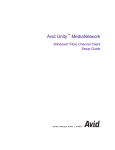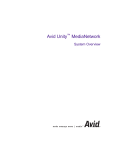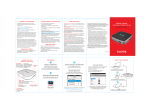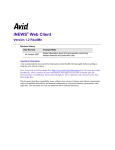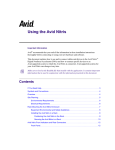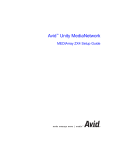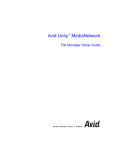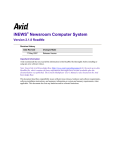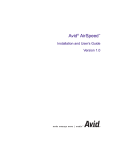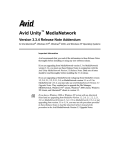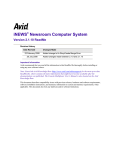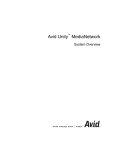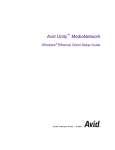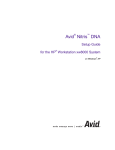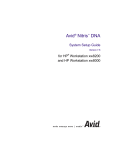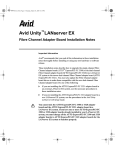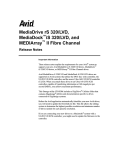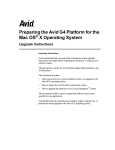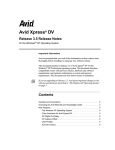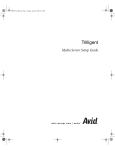Download Avid Technology Unity MediaNetwork PortServer Setup guide
Transcript
™ Avid Unity MediaNetwork ® Windows Fibre Channel Client Setup Guide m a k e m a n a g e m ove | m e d i a ™ Avid ® Copyright and Disclaimer Product specifications are subject to change without notice and do not represent a commitment on the part of Avid Technology, Inc. The software described in this document is furnished under a license agreement. You can obtain a copy of that license by visiting Avid's Web site at www.avid.com. The terms of that license are also available in the product in the same directory as the software. The software may not be reverse assembled and may be used or copied only in accordance with the terms of the license agreement. It is against the law to copy the software on any medium except as specifically allowed in the license agreement. Avid products or portions thereof are protected by one or more of the following United States Patents: 4,746,994; 4,970,663; 5,045,940; 5,267,351; 5,309,528; 5,355,450; 5,396,594; 5,440,348; 5,452,378; 5,467,288; 5,513,375; 5,528,310; 5,557,423; 5,577,190; 5,584,006; 5,640,601; 5,644,364; 5,654,737; 5,715,018; 5,724,605; 5,726,717; 5,729,673; 5,745,637; 5,752,029; 5,754,851; 5,799,150; 5,812,216; 5,828,678; 5,842,014; 5,852,435; 5,987,501; 6,061,758; 6,223,211; 6,301,105; 6,532,043; 6,546,190; 6,636,869; 6,747,705, 6,763,523; 6,813,622. Other patents are pending. No part of this document may be reproduced or transmitted in any form or by any means, electronic or mechanical, including photocopying and recording, for any purpose without the express written permission of Avid Technology, Inc. Copyright © 2005 Avid Technology, Inc. and its licensors. All rights reserved. Printed in USA. The following disclaimer is required by Sam Leffler and Silicon Graphics, Inc. for the use of their TIFF library: Copyright © 1988–1997 Sam Leffler Copyright © 1991–1997 Silicon Graphics, Inc. Permission to use, copy, modify, distribute, and sell this software [i.e., the TIFF library] and its documentation for any purpose is hereby granted without fee, provided that (i) the above copyright notices and this permission notice appear in all copies of the software and related documentation, and (ii) the names of Sam Leffler and Silicon Graphics may not be used in any advertising or publicity relating to the software without the specific, prior written permission of Sam Leffler and Silicon Graphics. THE SOFTWARE IS PROVIDED “AS-IS” AND WITHOUT WARRANTY OF ANY KIND, EXPRESS, IMPLIED OR OTHERWISE, INCLUDING WITHOUT LIMITATION, ANY WARRANTY OF MERCHANTABILITY OR FITNESS FOR A PARTICULAR PURPOSE. IN NO EVENT SHALL SAM LEFFLER OR SILICON GRAPHICS BE LIABLE FOR ANY SPECIAL, INCIDENTAL, INDIRECT OR CONSEQUENTIAL DAMAGES OF ANY KIND, OR ANY DAMAGES WHATSOEVER RESULTING FROM LOSS OF USE, DATA OR PROFITS, WHETHER OR NOT ADVISED OF THE POSSIBILITY OF DAMAGE, AND ON ANY THEORY OF LIABILITY, ARISING OUT OF OR IN CONNECTION WITH THE USE OR PERFORMANCE OF THIS SOFTWARE. The following disclaimer is required by the Independent JPEG Group: Portions of this software are based on work of the Independent JPEG Group. The following disclaimer is required by Paradigm Matrix: Portions of this software licensed from Paradigm Matrix. The following disclaimer is required by Ray Sauers Associates, Inc.: “Install-It” is licensed from Ray Sauers Associates, Inc. End-User is prohibited from taking any action to derive a source code equivalent of “Install-It,” including by reverse assembly or reverse compilation, Ray Sauers Associates, Inc. shall in no event be liable for any damages resulting from reseller’s failure to perform reseller’s obligation; or any damages arising from use or operation of reseller’s products or the software; or any other damages, including but not limited to, incidental, direct, indirect, special or consequential Damages including lost profits, or damages resulting from loss of use or inability to use reseller’s products or the software for any reason including copyright or patent infringement, or lost data, even if Ray Sauers Associates has been advised, knew or should have known of the possibility of such damages. The following disclaimer is required by Videomedia, Inc.: “Videomedia, Inc. makes no warranties whatsoever, either express or implied, regarding this product, including warranties with respect to its merchantability or its fitness for any particular purpose.” 2 “This software contains V-LAN ver. 3.0 Command Protocols which communicate with V-LAN ver. 3.0 products developed by Videomedia, Inc. and V-LAN ver. 3.0 compatible products developed by third parties under license from Videomedia, Inc. Use of this software will allow “frame accurate” editing control of applicable videotape recorder decks, videodisc recorders/players and the like.” The following disclaimer is required by Altura Software, Inc. for the use of its Mac2Win software and Sample Source Code: ©1993–1998 Altura Software, Inc. Attn. Government User(s). Restricted Rights Legend U.S. GOVERNMENT RESTRICTED RIGHTS. This Software and its documentation are “commercial computer software” or “commercial computer software documentation.” In the event that such Software or documentation is acquired by or on behalf of a unit or agency of the U.S. Government, all rights with respect to this Software and documentation are subject to the terms of the License Agreement, pursuant to FAR §12.212(a) and/or DFARS §227.7202-1(a), as applicable. Trademarks 888 I/O, Adrenaline, AirPlay, AirSPACE, AirSPACE HD, AniMatte, AudioSuite, AudioVision, AutoSync, Avid, Avid DNA, Avid DNxHD, AVIDdrive, AVIDdrive Towers, Avid Mojo, AvidNet, AvidNetwork, AVIDstripe, Avid Unity, Avid Xpress, AVoption, AVX, CamCutter, ChromaCurve, ChromaWheel, DAE, D-Fi, D-fx, Digidesign, Digidesign Audio Engine, Digidesign Intelligent Noise Reduction, DigiDrive, Digital Nonlinear Accelerator, DigiTranslator, DINR, D-Verb, Equinox, ExpertRender, FieldPak, Film Composer, FilmScribe, FluidMotion, HIIP, HyperSPACE, HyperSPACE HDCAM, IllusionFX, Image Independence, Intraframe, iS9, iS18, iS23, iS36, Lo-Fi, Magic Mask, make manage move | media, Marquee, Matador, Maxim, MCXpress, Media Composer, MediaDock, MediaDock Shuttle, Media Fusion, Media Illusion, MediaLog, Media Reader, Media Recorder, MEDIArray, MediaShare, Meridien, MetaSync, NaturalMatch, Nearchive, NetReview, NewsCutter, Nitris, OMF, OMF Interchange, OMM, Open Media Framework, Open Media Management, ProEncode, Pro Tools, QuietDrive, Recti-Fi, RetroLoop, rS9, rS18, Sci-Fi, Softimage, Sound Designer II, SPACE, SPACEShift, Symphony, the Avid|DS logo, Trilligent, UnityRAID, Vari-Fi, Video Slave Driver, VideoSPACE, and Xdeck are either registered trademarks or trademarks of Avid Technology, Inc. in the United States and/or other countries. iNEWS, iNEWS ControlAir, and Media Browse are trademarks of iNews, LLC. Macintosh is a trademark of Apple Computer, Inc., registered in the U.S. and other countries. Emulex is a registered trademark of Emulex Corporation. Microsoft, Windows, and Windows NT are either registered trademarks or trademarks of Microsoft Corporation in the United States and/or other countries. All other trademarks contained herein are the property of their respective owners. Avid Unity MediaNetwork Windows Fibre Channel Client Setup Guide• 0130-07132-01 • Rev A • June 2005 3 4 Contents Using This Guide. . . . . . . . . . . . . . . . . . . . . . . . . . . . . . . . . . . . . . . . 9 Symbols and Conventions . . . . . . . . . . . . . . . . . . . . . . . . . . . . . . . . . . . . . . . 9 If You Need Help . . . . . . . . . . . . . . . . . . . . . . . . . . . . . . . . . . . . . . . . . . . . . . 11 Related Information . . . . . . . . . . . . . . . . . . . . . . . . . . . . . . . . . . . . . . . . . . . . 12 How to Order Documentation . . . . . . . . . . . . . . . . . . . . . . . . . . . . . . . . . . . . 13 Avid Educational Services. . . . . . . . . . . . . . . . . . . . . . . . . . . . . . . . . . . . . . . 13 Chapter 1 Installing the MediaNetwork Windows Fibre Channel Client Hardware . . . . . . . . . . . . . . . . . . . . . . . . . . . . . . . . . . . . . . . . . . . . 15 Before You Begin . . . . . . . . . . . . . . . . . . . . . . . . . . . . . . . . . . . . . . . . . . . . . 16 Installing the Windows Client Hardware . . . . . . . . . . . . . . . . . . . . . . . . . . . . 16 Shutting Down the Avid Workstation . . . . . . . . . . . . . . . . . . . . . . . . . . . 16 Placing the Components . . . . . . . . . . . . . . . . . . . . . . . . . . . . . . . . . . . . 17 Adding the Fibre Channel Adapter Board . . . . . . . . . . . . . . . . . . . . . . . 17 Installing the Fibre Channel Adapter Board. . . . . . . . . . . . . . . . . . . 18 Connecting Cables to the Windows Client . . . . . . . . . . . . . . . . . . . 18 Connecting Cables to the MEDIASwitch 16-4G . . . . . . . . . . . . . . . . . . . 19 Port Configurations . . . . . . . . . . . . . . . . . . . . . . . . . . . . . . . . . . . . . 19 Connecting Cables to the LANserver EX . . . . . . . . . . . . . . . . . . . . . . . . 21 Turning On the Windows Client . . . . . . . . . . . . . . . . . . . . . . . . . . . . . . . 23 Using Windows 2000 Power Options . . . . . . . . . . . . . . . . . . . . . . . . . . . 23 Fibre Channel Adapter Board LED States . . . . . . . . . . . . . . . . . . . . . . . . . . 24 Chapter 2 Installing the MediaNetwork Windows 2000 or Windows XP Client Software . . . . . . . . . . . . . . . . . . . . . . . . . . . . . . . . . . . . . . . . . . . . 25 Installation Prerequisites . . . . . . . . . . . . . . . . . . . . . . . . . . . . . . . . . . . . . . . . 26 Fibre Channel Adapter Board Software . . . . . . . . . . . . . . . . . . . . . . . . . . . . 26 Installing the Avid Products Software. . . . . . . . . . . . . . . . . . . . . . . . . . . . . . 26 Installing the Client Software . . . . . . . . . . . . . . . . . . . . . . . . . . . . . . . . . . . . 27 Setting the Date, Time, and Time Zone . . . . . . . . . . . . . . . . . . . . . . . . . . . . 28 Additional Client Procedures . . . . . . . . . . . . . . . . . . . . . . . . . . . . . . . . . . . . 28 Chapter 3 Networking the MediaNetwork Clients . . . . . . . . . . . . . . . . . . . . . 29 Network Connection Methods . . . . . . . . . . . . . . . . . . . . . . . . . . . . . . . . . . . 30 Connecting a Fibre Channel Client to a Network . . . . . . . . . . . . . . . . . . . . . 30 Using the Built-in Network Port . . . . . . . . . . . . . . . . . . . . . . . . . . . . . . . 31 Using an Ethernet Peripheral Board . . . . . . . . . . . . . . . . . . . . . . . . . . . 31 Appendix A Installing the Fibre Channel Adapter Board Firmware. . . . . . . . . 33 Appendix B Regulatory and Safety Notices. . . . . . . . . . . . . . . . . . . . . . . . . . . . 35 Warnings and Cautions . . . . . . . . . . . . . . . . . . . . . . . . . . . . . . . . . . . . . . . . 35 FCC Notice. . . . . . . . . . . . . . . . . . . . . . . . . . . . . . . . . . . . . . . . . . . . . . . . . . 35 Canadian ICES-003 . . . . . . . . . . . . . . . . . . . . . . . . . . . . . . . . . . . . . . . . . . . 36 European Union Notice . . . . . . . . . . . . . . . . . . . . . . . . . . . . . . . . . . . . . . . . 36 Australia and New Zealand EMC Regulations . . . . . . . . . . . . . . . . . . . . . . . 38 Taiwan EMC Regulations. . . . . . . . . . . . . . . . . . . . . . . . . . . . . . . . . . . . . . . 38 Index . . . . . . . . . . . . . . . . . . . . . . . . . . . . . . . . . . . . . . . . . . . . . . . . . 39 6 7 Illustrations Attaching an Optical Cable to the Fibre Channel Adapter Board . . . . . . . . . . 19 MEDIASwitch 16-4G Port Configuration . . . . . . . . . . . . . . . . . . . . . . . . . . . . 20 Installing an SFP Connector. . . . . . . . . . . . . . . . . . . . . . . . . . . . . . . . . . . . . . 21 Attaching an Optical Cable to the LANserver EX . . . . . . . . . . . . . . . . . . . . . . 22 Connecting a Client to a Network Using the Ethernet Port . . . . . . . . . . . . . . 31 8 Using This Guide You can connect your Avid Unity™ MediaNetwork Windows® Fibre Channel client to a MediaNetwork workgroup to share media files and other project data with various Avid® workstations. See the latest Avid Unity MediaNetwork release notes for the client systems and software supported by this release. n This document might not be updated with every revision of the Avid Unity software. The above Windows and Macintosh systems might be different. See the latest release notes for an up to date list of supported systems. The documentation describes the features and hardware of all models. Therefore, your system might not contain certain features and hardware that are covered in the documentation. Symbols and Conventions Unless otherwise noted, the MediaNetwork Windows Fibre Channel client documentation applies to the Windows NT, Windows 2000, and Windows XP operating systems. Avid documentation uses the following symbols and conventions: Symbol or Convention Meaning or Action n A note provides important related information, reminders, recommendations, and strong suggestions. c A caution means that a specific action you take could cause harm to your computer or cause you to lose data. Using This Guide Symbol or Convention Meaning or Action w 10 A warning describes an action that could cause you physical harm. Follow the guidelines in this document or on the unit itself when handling electrical equipment. > This symbol indicates menu commands (and subcommands) in the order you select them. For example, File > Import means to open the File menu and then select the Import command. t This symbol indicates a single-step procedure. Multiple arrows in a list indicate that you perform one of the actions listed. Margin tips In the margin, you will find tips that help you perform tasks more easily and efficiently. Italic font Italic font is used to emphasize certain words and to indicate variables. Courier Bold font Courier Bold font identifies text that you type. Click Quickly press and release the left mouse button (Windows) or the mouse button (Macintosh). Double-click Click the left mouse button (Windows) or the mouse button (Macintosh) twice rapidly. Right-click Quickly press and release the right mouse button (Windows only). Drag Press and hold the left mouse button (Windows) or the mouse button (Macintosh) while you move the mouse. Ctrl+key Press and hold the first key while you press the second key. If You Need Help If You Need Help If you are having trouble using your MediaNetwork Windows Fibre Channel client, you should: 1. Retry the action, carefully following the instructions given for that task in this guide. It is especially important to check each step of your workflow. 2. Check for the latest information that might have become available after the documentation was published in one of two locations: n - If release notes are available, they ship with your application. - If ReadMe files are available, they are supplied in your Avid application folder. ReadMe files are also available from Help. Release notes and ReadMe files are also available on the Avid Knowledge Center. 3. Check the documentation that came with your Avid application or your hardware for maintenance or hardware-related issues. 4. Visit the online Knowledge Center at www.avid.com/support. Online services are available 24 hours per day, 7 days per week. Search this online Knowledge Center to find answers, to view error messages, to access troubleshooting tips, to download updates, and to read/join online message-board discussions. 11 Using This Guide Related Information The following documents located on the Documentation CD-ROM provide more information about the MediaNetwork workgroup, the MediaNetwork client, and other storage options: n 12 • Avid Unity MediaNetwork Site Preparation Guide • Avid Unity MediaNetwork File Manager Setup Guide • Avid Unity MediaNetwork File Manager Failover Installation Notes • Avid Unity MediaNetwork Upgrade Notes • Avid Unity MediaNetwork System Overview • Avid Unity MediaNetwork Management Guide (also printed) • Avid Unity MediaNetwork Macintosh Fibre Channel Client Setup Guide • MediaNetwork Macintosh Fibre Channel Client Quick Start Card • MediaNetwork Windows Fibre Channel Client Quick Start Card • Avid Unity MediaNetwork Macintosh Ethernet Client Setup Guide • MediaNetwork Macintosh Ethernet Client Quick Start Card • Avid Unity MediaNetwork Windows Ethernet Client Setup Guide • MediaNetwork Windows Ethernet Client Quick Start Card • Avid Unity MediaNetwork Release Notes • Avid Unity LANserver EX3 Setup Guide • Avid Unity LANserver Upgrade Notes • Avid Unity LANserver Release Notes • Avid Unity MediaNetwork PortServer Setup Guide • Avid Unity MediaNetwork Supported Configurations • Avid MEDIArray ZX4 Setup Guide For the latest product information, see the Avid Knowledge Base. How to Order Documentation How to Order Documentation To order additional copies of this documentation from within the United States, call Avid Sales at 800-949-AVID (800-949-2843). If you are placing an order from outside the United States, contact your local Avid representative. Avid Educational Services For information on courses/schedules, training centers, certifications, courseware, and books, please visit www.avid.com/training or call Avid Sales at 800-949-AVID (800-949-2843). 13 Using This Guide 14 Chapter 1 Installing the MediaNetwork Windows Fibre Channel Client Hardware Installing the Avid Unity MediaNetwork Windows Fibre Channel client on your Avid workstation requires adding hardware and software to create a functioning Windows client. When your Avid workstation becomes a Windows client, it connects to a Fibre Channel Arbitrated Loop (FC-AL). This loop requires that you add a Fibre Channel adapter board to the Windows client you are connecting to the MediaNetwork workgroup. This chapter includes the following topics: • Before You Begin • Installing the Windows Client Hardware • Fibre Channel Adapter Board LED States Chapter 1 Installing the MediaNetwork Windows Fibre Channel Client Hardware Before You Begin Keep the shipping boxes that come with your Windows client. You might need to repackage and ship the components in the future. Before you begin to install the Windows client hardware, do the following: • Unpack the Windows client kit. • Check the contents of the Windows kit against the packing sticker on the outside of the shipping box to confirm you have received all the components. After you unpack your Windows client kit, make sure the kit contains: n • One 4-Gb optical Fibre Channel adapter board for the Windows client • One optical small form-factor pluggable (SFP) connector • One Windows client software kit containing - Avid Unity MediaNetwork Windows Fibre Channel Client Setup Guide on the Avid Unity MediaNetwork Documentation CD-ROM. - Avid Unity MediaNetwork software CD-ROM. Avid does not supply an optical cable with the Windows client kit. You must supply the cable separately. Installing the Windows Client Hardware The Windows client kit allows you to connect your Avid workstation to the MediaNetwork workgroup. You can connect an existing Avid workstation or a new Avid workstation to the workgroup. To install the Windows client hardware: t If you are connecting an existing Avid workstation, begin your installation with “Shutting Down the Avid Workstation” on page 16. t If you are connecting a new Avid workstation, begin your installation with “Placing the Components” on page 17. Shutting Down the Avid Workstation Before you install the Windows client hardware, shut down the Avid workstation you are adding to the MediaNetwork workgroup. 16 Installing the Windows Client Hardware To shut down the workstation: 1. Quit all running applications. 2. Click the Start button, and select Shut Down. The Shut Down Windows dialog box opens. 3. Select Shut down, and then click OK. 4. After the Avid workstation shuts down, turn off the power to the workstation and to all connected peripherals. Placing the Components When you are setting up your Windows client: n • Position the components for the Windows client as described in the setup guide that came with your Avid product. • Position the Windows client within the limits of the optical cable you are using: - 1650 feet (500 meters) maximum for 50-micrometer (μm) 125 optical cables - 575 feet (175 meters) maximum for 62.5-μm 125 optical cables Avid does not support copper cables for 4-Gb Fibre Channel adapter boards. Adding the Fibre Channel Adapter Board You connect the MediaNetwork workgroup to the Fibre Channel adapter board in the Windows client through the MEDIASwitch 16-4G. The MEDIASwitch 16-4G allows several MediaNetwork clients to access the MediaNetwork workgroup at the same time. c The peripheral boards are sensitive to electrostatic discharge. Do not handle any of the boards unless you are properly grounded or have discharged yourself. 17 Chapter 1 Installing the MediaNetwork Windows Fibre Channel Client Hardware Installing the Fibre Channel Adapter Board You need to install a Fibre Channel adapter board in the Windows client that you are connecting to the MediaNetwork workgroup. The location of the adapter board in your workstation depends on the workstation platform you are using, the type of video I/O on the platform, and the location of other Avid peripheral boards within the workstation. n The Fibre Channel adapter board is installed in different slots in the different Avid products workstations. To determine the correct slot for installing the adapter board, see the setup guide, or go to www.Avid.com for slot configurations concerning your workstation. Connecting Cables to the Windows Client The Windows client requires an optical cable with an LC optical cable connector on the client end of the cable. If you need to install an optical cable for the Windows client, contact your optical cable installer to arrange for them to install a 50-μm or 62.5-μm multimode cable. If you are installing the optical cable for use with a 4-Gb MEDIASwitch 16-4G, the cable needs LC optical cable connectors at both ends. n Before you begin the Windows client hardware installation, make sure the optical cables have been installed. Look in the area where you are installing the client for a loose cable end. To connect an optical cable to the Windows client: 1. Locate the optical cable. Look for a cable with a dual plug on one end (see “Attaching an Optical Cable to the Fibre Channel Adapter Board” on page 19). 2. Remove the protective covers from the optical connector on the optical cable and the Fibre Channel adapter board in the client. 3. Plug the optical cable connector into the adapter board connector. as shown in “Attaching an Optical Cable to the Fibre Channel Adapter Board” on page 19. You should hear a click when the cable is properly seated. 18 Installing the Windows Client Hardware c Do not force the optical cable connector into the adapter board connector. There should be no resistance as you put them together. If the cable connector does not fit into the adapter board connector, turn the cable connector 180 degrees and try to insert it again. LEDs Optical cable Fibre Channel adapter board Optical cable Optical cable connector Attaching an Optical Cable to the Fibre Channel Adapter Board 4. Do one of the following: t Attach the other end of the optical cable to the MEDIASwitch 16-4G as described in “Connecting Cables to the MEDIASwitch 16-4G” on page 19. t If you are attaching the other end of the optical cable to a LANserver EX, continue with “Connecting Cables to the LANserver EX” on page 21. Connecting Cables to the MEDIASwitch 16-4G The MEDIASwitch 16-4G connects the MediaNetwork workgroup to several MediaNetwork clients. The switch allows the MediaNetwork clients to use the storage simultaneously. The switch prevents work interruptions by allowing other clients in the workgroup to continue working if one or more clients go offline. Port Configurations The shipping 4-Gb MEDIASwitch 16-4G uses an SFP connector to connect the cables to the switch. As shown in “MEDIASwitch 16-4G Port Configuration” on page 20, each MEDIASwitch 16-4G has 16 Ports, 0 through 15. The File Manager should connect to Port 0 with Port 1 used for 19 Chapter 1 Installing the MediaNetwork Windows Fibre Channel Client Hardware FailOver File Manager if you have one. You should connect storage starting at Port 15 and go to Port 10, for a maximum of 6. All remaining ports can be used to connect MediaNetwork clients. n Any ports, 15 through 10, not used for storage can be used as client ports. Storage ports File Manager port a Port 0 Port 15 MediaNetwork client ports MEDIASwitch 16-4G Port Configuration Connecting to a 4-Gb MEDIASwitch 16-4G To connect an optical cable to the 4-Gb MEDIASwitch 16-4G: 1. Locate the SFP in the Windows client kit. 2. Route the cable from the Windows client to the MEDIASwitch 16-4G, if it has not been installed already. 3. Position the SFP in front of a MEDIASwitch 16-4G port (see the following figure). Make sure the optical connector is facing away from the MEDIASwitch 16-4G. n 20 You can install the SFP while the MEDIASwitch 16-4G is turned on. Installing the Windows Client Hardware a SFP SFP a Installing an SFP Connector 4. Slide the SFP into the MEDIASwitch 16-4G port. You should hear a click when the SFP is seated in the port. 5. Remove the protective covers from the optical connector on the optical cable. 6. Remove the protective cover from the SFP in the MEDIASwitch 16-4G. 7. Attach the connector on the cable into the SFP for the client. Firmly push the plug on the cable into the connectors on the SFP. 8. Label the cable with the name or location of the Windows client to which it connects. Connecting Cables to the LANserver EX The LANserver EX allows you to connect up to five Fibre Channel clients to use the storage simultaneously with any attached Ethernet clients. The Fibre Channel clients connect directly to the dual-channel Fibre Channel boards in the LANserver EX. 21 Chapter 1 Installing the MediaNetwork Windows Fibre Channel Client Hardware To connect a Windows client to the LANserver EX: 1. Locate the optical cable. Look for a cable with a dual plug on the end (see “Attaching an Optical Cable to the LANserver EX” on page 22). 2. Make sure the cable has an LC (small) optical connector to match the connector on the adapter board in the LANserver EX. If the connector is not the correct one, contact your optical cable installer to arrange for them to change the connector. 3. Remove the protective covers from the optical connector on the optical cable. 4. Remove the protective cover from the Fibre Channel adapter board in the LANserver EX. 5. Plug the optical cable connector into the adapter board connector. The cable connector and the adapter board connector are keyed and fit together only one way. You should hear a click when the cable is properly seated. c Do not force the optical cable connector into the adapter board connector. There should be no resistance as you put them together. If the cable connector does not fit into the adapter board connector, turn the cable connector 180 degrees and try to insert it again. Attaching an Optical Cable to the LANserver EX Optical cable Fibre Channel adapter board Ethernet adapter board Optical cable connector 22 Installing the Windows Client Hardware Turning On the Windows Client When you finish connecting the Windows client hardware and cables, you can start up the client. Before you start up the Windows client, make sure the File Manager is installed and running. To start up your Windows client: 1. Turn on all the peripherals connected to the Windows client. Make sure their power lights are on. 2. Press the Power button on the Windows client. The MEDIASwitch 16-4G port lights are on when the client is ready. n Before you attempt to install the MediaNetwork Windows Fibre Channel client software, make sure the Windows client starts up properly. Using Windows 2000 Power Options Windows 2000 offers power options to help manage power consumption on your Windows 2000 workstation. Avid recommends you do not use the power options to cause your workstation to go into Standby or Hibernate mode. c Two of the power options, Standby and Hibernate, can cause all the drives connected to a workstation (both local drives and remote drives connected through MEDIASwitch 16-4G) to go into an inactive mode. This prevents the File Manager from seeing the drive set and rebooting. Also, all clients with mounted workspaces are unusable until the File Manager and the storage are available again. 23 Chapter 1 Installing the MediaNetwork Windows Fibre Channel Client Hardware Fibre Channel Adapter Board LED States You can use the Fibre Channel adapter board LEDs to determine if the adapter board is working or might be experiencing problems. Table “LED States and Required Action” shows the LED colors, the LED states and meanings, and the action you should take if a failure occurs. LED States and Required Action LED Color LED State Meaning Required Action Green On Normal (link up) No action is required. Yellow On Link down Check the cable connections to the MEDIASwitch 164G and the adapter board. If the condition persists, contact Avid Customer Support. Yellow Flashing Fault Contact Avid Customer Support. Green or Yellow Off Driver not installed Install the driver. If the condition persists, contact Avid Customer Support. 24 Chapter 2 Installing the MediaNetwork Windows 2000 or Windows XP Client Software The MediaNetwork Windows 2000 client and Windows XP Professional client need the correct software to function properly in the MediaNetwork workgroup. The following sections describe the software and how to install each software component: • Installation Prerequisites • Fibre Channel Adapter Board Software • Installing the Avid Products Software • Installing the Client Software • Setting the Date, Time, and Time Zone • Additional Client Procedures Chapter 2 Installing the MediaNetwork Windows 2000 or Windows XP Client Software Installation Prerequisites The Windows Fibre Channel client software requires that you install several software packages before you start an installation. Installing a MediaNetwork client without the prerequisite software packages causes the client installer to quit. The Fibre Channel client requires the following software: • Windows 2000 Service Pack 4, or Windows XP Service Pack 2 • Internet Explorer 5.5 or later If you need to install a copy of Internet Explorer, a copy of the browser is provided on the MediaNetwork CD-ROM in the directory \Extras\IE\IE5 (Internet Explorer 5.5) or \Extras\IE\IE6 (Internet Explorer 6.0). n You should go to the Avid Knowledge Base and see the Microsoft Service Pack and Security Bulletin Addendum for any security issues relating to hotfixes for your Windows 2000 Professional operating system or Windows XP Professional operating system. Fibre Channel Adapter Board Software After you install the Fibre Channel adapter board in the Windows client, you need to install the latest Fibre Channel adapter software. The Avid Unity MediaNetwork CD-ROM contains an ATTO™ driver specific for your board. See the Avid Unity MediaNetwork release notes for the instructions on loading the driver and firmware if needed. Installing the Avid Products Software The Windows 2000 or Windows XP Fibre Channel client requires a qualified version of the Avid products software, which allows it to use the MediaNetwork shared storage when the client is connected to a MediaNetwork workgroup. Before you install the Fibre Channel client software, install the qualified version of the Avid products software. To determine if you have a qualified version of the Avid products software, see the Avid Unity MediaNetwork Release Notes. 26 Installing the Client Software Installing the Client Software Each Windows 2000 or Windows XP Fibre Channel client requires software that allows it to log in to the MediaNetwork File Manager and to map accessible workspaces. The Windows Fibre Channel client software is provided on the MediaNetwork CD-ROM. To install the Windows Fibre Channel client software: 1. Insert the MediaNetwork CD-ROM in the Windows client CD-ROM drive. The CD-ROM is set to start automatically and open the Avid Unity Installation window. This takes approximately 1 minute. If the CD-ROM does not start automatically, start the installation manually as follows: a. Double-click the My Computer icon on the desktop. The My Computer window opens. b. Right-click the CD-ROM icon, and select AutoPlay. The Avid Unity Installation window opens. 2. Click Product Installers. 3. Click MediaNetwork Components on the list of available products. 4. Click Install Fibre Attached Client on the list of MediaNetwork installers. The Question dialog box opens, listing the prerequisite software needed for installation. - If all the software is installed, click Next and continue with step 5. The InstallShield Wizard dialog box opens. - If some of the software is not installed, click Cancel to exit the installer. Install the prerequisite software, and go to step 1 to begin the MediaNetwork installation again. 5. Accept the default values presented by the InstallShield Wizard. The Setup Status screen appears, showing the installation progress indicator while the software is being installed. The InstallShield Wizard Complete opens. 6. Select “Yes, I want to restart my computer now,” and then click Finish to complete the client software installation. 7. Reboot the client. 27 Chapter 2 Installing the MediaNetwork Windows 2000 or Windows XP Client Software Setting the Date, Time, and Time Zone You need to set the date, time, time zone, and Daylight Saving Time options correctly on the Windows client. This allows the “Synchronize time with server” function on the client to work properly. To set the date, time, time zone, and Daylight Saving Time options on the Windows client: 1. Double-click the time in the taskbar. The Date/Time Properties dialog box opens. 2. Set the date and time using the Date & Time tab. 3. Click the Time Zone tab. 4. Set the time zone for the location of the Windows client. By default, Windows sets the time zone to “(GMT - 8:00) Pacific Time (US & Canada); Tijuana.” 5. If your location observes Daylight Saving Time, select “Automatically adjust clock for daylight saving changes.” 6. Click OK to close the dialog box and save the settings. 7. Reboot the client. Additional Client Procedures You have completed the installation of the Windows 2000 or Windows XP client. 28 • If you need to connect your Windows client to a network, continue with Chapter 3. • If you need to create user accounts and workspaces for the client, see the Avid Unity MediaNetwork Management Guide. Chapter 3 Networking the MediaNetwork Clients You can connect your Windows Fibre Channel client to an Ethernet network so it can share project information with other MediaNetwork clients. You can also use the network connection to allow TransferManager and MediaManager to move and control your video media, graphics and effects, audio media, and finishing materials. n n An Ethernet network is not required for Windows clients. Avid does not install, configure, or troubleshoot Ethernet networks. If you are having trouble with your network, consult your Information Services department or your network vendor. Avid does install and configure Windows clients that communicate over Ethernet networks. The Ethernet network can be either a standalone network or an existing in-house network. The network can be either 10BASE-T/100BASE-T, or 1000BASE-T. The client must be properly configured with a valid IP address and a subnet mask. Topics in this chapter include the following: • Network Connection Methods • Connecting a Fibre Channel Client to a Network Chapter 3 Networking the MediaNetwork Clients Network Connection Methods You can connect your MediaNetwork clients to the network by: t Attaching one or more clients directly to the network. Ethernet MediaNetwork client t MediaNetwork client MediaNetwork client Attaching one or more clients to the network through a router. The router allows you to segregate the MediaNetwork clients from the rest of the network. Ethernet Router MediaNetwork client MediaNetwork client MediaNetwork client Connecting a Fibre Channel Client to a Network You can connect your Windows Fibre Channel client to an Ethernet network in several ways: • Through the built-in Ethernet port on the Windows client • Through an optional Ethernet peripheral board Each connection is described in the following sections. 30 Connecting a Fibre Channel Client to a Network Using the Built-in Network Port To connect a Fibre Channel client with a built-in Ethernet port to the site network: 1. Connect one end of the Ethernet cable to the Ethernet port on the rear of the client (see “Connecting a Client to a Network Using the Ethernet Port” on page 31). 2. Connect the other end of the Ethernet cable to a site network jack. Using an Ethernet Peripheral Board To connect a Fibre Channel client with an optional 10/100BASE-T Ethernet peripheral board to the site network: 1. Install the Ethernet peripheral board as described in the manufacturer’s documentation. 2. Connect the Ethernet cable to the Ethernet port on the Ethernet board (see “Connecting a Client to a Network Using the Ethernet Port” on page 31). 3. Connect the other end of the Ethernet cable to a site network jack. Ethernet port (on Windows workstation or on optional Ethernet board) RJ-45 connector To site network jack Ethernet cable Connecting a Client to a Network Using the Ethernet Port 31 Chapter 3 Networking the MediaNetwork Clients 32 Appendix A Installing the Fibre Channel Adapter Board Firmware You should not need to reinstall the Fibre Channel adapter board firmware. Each board ships with the correct firmware already installed. In some cases, the firmware might become corrupted. If this occurs, install the firmware under the direction of Avid Customer Support using one of the following documents located on the Avid Unity Documentation CD-ROM: • ReadMe • Release Notes • Upgrade Notes Appendix A Installing the Fibre Channel Adapter Board Firmware 34 Appendix B Regulatory and Safety Notices Warnings and Cautions w w w c c Never install equipment if it appears damaged. Disconnect the power cord before servicing unit. Only perform the services explicitly described in this document. For services or procedures not outlined in this document, speak with authorized Avid service personnel. Follow all warnings and cautions in the procedures. Operate the device within its marked electrical ratings and product usage instructions. FCC Notice This device complies with Part 15 of the FCC Rules. Operation is subject to the following two conditions: 1. This device may not cause harmful interference. 2. This device must accept any interference received, including interference that may cause undesired operation. This equipment has been tested and found to comply with the limits for a Class A digital device, pursuant to Part 15 of the FCC Rules. These limits are designed to provide reasonable protection against harmful interference when the equipment is operated in a commercial environment. This equipment Appendix B Regulatory and Safety Notices generates, uses, and can radiate radio frequency energy and, if not installed in accordance with the instruction manual, may cause harmful interference to radio communications. Operation of this equipment in a residential area is likely to cause harmful interference in which case the user will be required to correct the interference at his own expense. Canadian ICES-003 This Class A digital apparatus meets all requirements of the Canadian Interference Causing Equipment Regulations. Cet appareil numérique de la classe A respecte toutes les exigences du Règlement sur le matériel brouilleur du Canada. European Union Notice Declaration of Conformity (According to ISO/IEC Guide 22 and EN 45014) Application of Council Directives: 73/23/EEC, 89/336/EEC. Standards to which EN60950:1999 Third Edition Conformity is Declared: CISPR 22:1997 / EN55022:1994 + A1:1995 + A2:1997 Class A EN55024:1998/EN61000 — 3-2, 4-2, 4-3, 4-4, 4-5, 4-6, 4-11 36 Manufacturer’s Name: Avid Technology, Inc. 1925 Andover Street Tewksbury, MA 01876, USA European Contact: Nearest Avid Sales and Service Office or Avid Technology International B.V. Sandyford Business Center Unit 3, Dublin 18, Ireland Type of Equipment: Information Technology Equipment European Union Notice Product Name: Products for the Windows NT, Windows 2000, or Windows XP Operating System: Avid Adrenaline DNA, Avid DS Nitris DNA, Avid Equinox Break-Out-Box, Avid|DS, Avid Xpress, Avid Xpress DV, Film Composer, Media Composer, MediaDock, MediaDock 2+, MediaDrive, MediaRAID, MEDIArray, MEDIArray Drive, MEDIArray II, MEDIArray II Drive, Meridien I/O box, NewsCutter, NewsCutter DV, NewsCutter XP, Pro Tools AVoption|V10, Symphony Products for the Mac OS X Operating System: Avid Adrenaline DNA, Avid Xpress, Avid Xpress DV, Film Composer, Media Composer, MediaDock, MediaDock 2+, MediaDrive, MediaRAID, MEDIArray, MEDIArray Drive, MEDIArray II, MEDIArray II Drive, Meridien I/O box, Pro Tools AVoption|V10, Symphony Products for the UNIX Operating System: AirPlay, AirSPACE, AirSpeed, VideoSPACE Products for MediaNetwork and Workgroups: Avid ProEncode, Avid Unity MediaManager, Avid Unity MediaNetwork (includes File Manager), Avid Unity TransferManager, LANserver, LANserver EX, MEDIArray, MEDIArray Drive, MEDIArray II, MEDIArray II Drive, MEDIArray ZX, MEDIArray ZX Drive, Nearchive, PortServer, Vixel switches (8100, 7100, 7200, 9100, 9200), Xdeck Base Model Numbers: None Product Options: All Year of Manufacture: 2004 (1) Products for the Windows NT, Windows 2000, or Windows XP Operating System: products were tested in a typical Avid Adrenaline DNA, Avid DS Nitris DNA, Avid Equinox Break-Out-Box, Avid|DS, Avid Xpress, Avid Xpress DV, Film Composer, Media Composer, MediaDock, MediaDock 2+, MediaDrive, MediaRAID, MEDIArray, MEDIArray Drive, MEDIArray II, MEDIArray II Drive, Meridien I/O box, NewsCutter, NewsCutter DV, NewsCutter XP, Pro Tools AVoption|V10, or Symphony configuration. (2) Products for the Mac OS X Operating System: products were tested in a typical Avid Adrenaline DNA, Avid Xpress, Avid Xpress DV, Film Composer, Media Composer, MediaDock, MediaDock 2+, MediaDrive, MediaRAID, MEDIArray, MEDIArray Drive, MEDIArray II, MEDIArray II Drive, Meridien I/O box, Pro Tools AVoption|V10, or Symphony configuration. 37 Appendix B Regulatory and Safety Notices (3) Products for the UNIX Operating System: products were tested in an AirPlay, AirSpeed, or VideoSPACE configuration. (4) Products for MediaNetwork and Workgroups: products were tested in a typical Avid ProEncode, Avid Unity MediaManager, Avid Unity MediaNetwork (includes File Manager), Avid Unity TransferManager, LANserver, LANserver EX, MEDIArray, MEDIArray Drive, MEDIArray II, MEDIArray II Drive, MEDIArray ZX, MEDIArray ZX Drive, Nearchive, PortServer, or Xdeck configuration. I, the undersigned, hereby declare that the equipment specified above conforms to the above Directives and Standards. George R. Smith, Director of Hardware Engineering Australia and New Zealand EMC Regulations John Kells, Australian Operations Manager Avid Technology (Australia) Unit B 5 Skyline Place French Forest NSW 2086 Australia Phone: 61-2-8977-4800 Taiwan EMC Regulations Taiwan EMC Regulations BSMI Class A EMC Warning 38 Index A M Australia EMC regulations 38 MediaShare F/C connecting Avid system 17 installing 15 placing components 17 starting 23 unpacking 16 C Cabling Avid system 17 Canadian interference causing equipment regulations 36 Component placing 17 Connecting to a network 29, 30 Controller board installing 18 E Ethernet 29 Ethernet, connecting to 30 European Union notice 36 N Network, connecting to 30 New Zealand EMC regulations 38 O Optical cable 18, 22 R Regulatory information 35 Router, connecting to 30 F FCC notice 35 I Installing controller board 18 S Safety information 35 Subnet masks same for all clients 30 system configured with 29 T Taiwan EMC regulations 38 Index 40








































